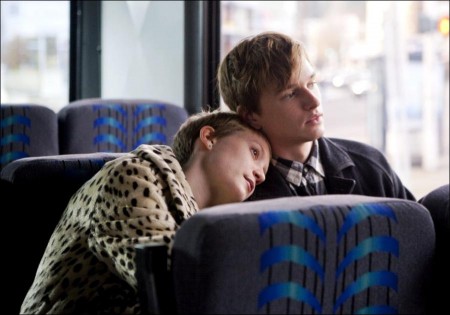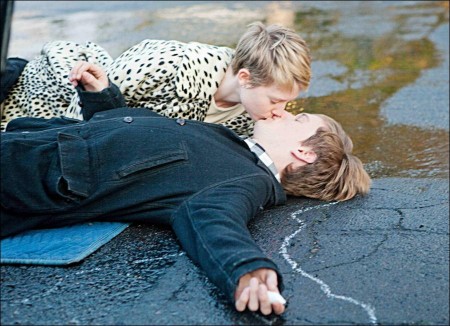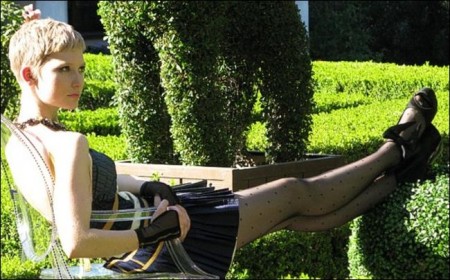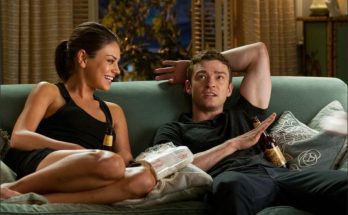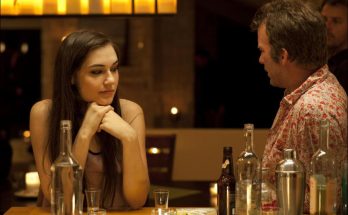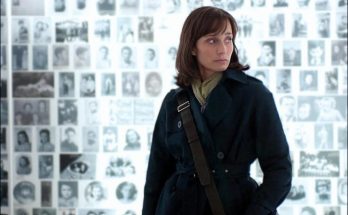Taglines: Who do you live for?
Annabel Cotton (Mia Wasikowska) is a beautiful terminal cancer patient with a deep felt love of life and the natural world. Enoch Brae is a young man who has dropped out of the business of living, after an accident claimed the life of his parents. When two outsiders chance to meet at a funeral, they find an unexpected common ground in their experiences of the world.
For Enoch, it includes his best friend Hiroshi who happens to be the ghost of a Kamikaze fighter pilot. For Annabel, it involves an admiration of Charles Darwin and an interest in how other creatures live. Upon learning of Annabel’s imminent early passing, Enoch offers to help her face her last days with an irreverent abandon, tempting fate, tradition and even death itself.
As their unique love for each other grows, so do the realities of the world that they have felt closing in on them. Daring, childlike, and distinctly rare – these two bravely face what life has in store for them. Fighting pain, anger and loss with youth, playfulness and originality, these two misfits turn the tables on life and play by their own rules. Their journey begins to collide with the unstoppable march of time, as the natural cycle of life comes to claim Annabel.
For a quarter-century, Van Sant has drawn sympathetic portraits of young outsiders, but in directing Jason Lew’s soggy script he has drawn a blank. These are kids the world just doesn’t understand, yet they have no edges, few shades and scant access to even a sympathetic heart. Van Sant has so little confidence in the material that he wallpapers virtually every scene in pop music: Beatles songs, French ballads, soulful rock and Danny Elfman’s uncharacteristically sentimental score.
What little emotive resonance Restless summons comes from the charm surgically implanted in it by the two attractive stars. Hopper — who looks like his dad as a teenager, crossed with a hint of James Dean — should some day be worth watching. Wasikowska always is, even here, where she gives her all to turning a romance-novel cliché into a good and trusting soul. She will be back in Cannes with better films.
About the Production
“We have so little time to say any of the things we mean. We have so little time for any of it.” – Hiroshi the Ghost in Restless
Young love has long been the stuff of great drama, from Shakespeare’s star-crossed Romeo and Juliet to the tear-jerking sentiment of Love Story. Now, from screenwriter Jason Lew and director Gus Van Sant comes a timeless and unique story that breathes new life into the old familiar tale. Restless tells the story of a young man hiding from his life, and the vibrant young woman who brings him out of his shell. Echoing and evoking memorable film classics such as Hal Ashby’s Harold and Maude and recent indie hits such as Garden State, Restless aims for the head as well as the heart, offering rich characters and a deceptively simple story that will leave a lingering impression on film audiences.
Featuring newcomer Henry Hopper as shy and alienated teenager Enoch Brae, Restless takes place over the course of a cold American autumn. While nature heads towards a long slumber, young Henry makes his way through the world already frozen; devastated by the memory of his parents’ death in an automobile accident. Yet in the midst of his self-imposed exile, Enoch finds his worldview changing because of the presence of charming and intelligent Annabel Cotton, played by Mia Wasikowska.
The relationship between Enoch and Annabel anchors the film, and the characters resonate as timeless because of their depth and maturity, a product of the collaboration between the film’s principal creators. Writer Jason Lew was a classmate at New York University with producer Bryce Dallas Howard, and Restless was initially the product of a series of short plays and vignettes that allowed them to explore the story and the characters. “Ultimately, I wanted to see if I could marry them and fuse them all together into one story,” Lew says today, “and I banged out the rough draft of a play.”
After he moved to Los Angeles, Lew’s friends, including Howard, suggested adapting the play into a screenplay. “Jason’s not a calculating writer; he’s all passion,” says Howard. “The play is heartbreakingly beautiful, but theater and film are very different. As he adapted it into a screenplay, a stronger story emerged. Everything that made it special as a play remained, and bigger elements were introduced that made it a piece of cinema.”
Howard’s passion for the project is what spurred her to make this film her producing debut. “This film is like her baby,” says Wasikowska. “She was on set, every day, working extremely hard. She’s dedicated, and, being an actor herself, she’s so caring and understanding. She worked to make sure everyone was comfortable.” Howard also knew that this small, intimate project would need careful shepherding as it made its way through the production process. “I wanted it to be at a place where I felt it was going to be totally protected,” she explains.
“After receiving interest from several producers, the production company that showed the most genuine passion for this screenplay happened to be Imagine Entertainment, my father’s company. In the past I had been hesitant as an actor to work with my Dad. I honestly didn’t want us to ever be accused of nepotism. But my primary responsibility with Restless was to find a home for this film that exhibited a shared vision of what was possible. It was undeniable that that was Imagine, Brian Grazer and my father. And after working together these past few years, I must admit – I don’t think there was a better person in the world to mentor, support, and protect this project than my own dad.”
The involvement of Imagine and veteran Oscar®-winning producers Ron Howard and Brian Grazer helped bring about the participation of Gus Van Sant. One of the cinema’s most original and iconoclastic voices, Van Sant was perhaps the ideal choice to bring a mature and professional sensibility without losing any of the screenplay’s unique spirit. Indeed, many of Van Sant’s more successful and memorable films are about characters that represent youthful energy and passion on the edge of a painfully cold world. Even though the subject matter is quite different, the story of Enoch and Annabel echoes the troubled journeys taken by heroes of Van Sant’s previous films as diverse as My Own Private Idaho, Good Will Hunting, Elephant, and Milk.
Lew’s timeless screenplay also seems to delight in drawing on familiar ideas from the past. Annabel and Enoch, although thoroughly believable as contemporary characters, are in such unique and gripping emotional situations that one barely realizes that the film doesn’t bother to show them using cell phones or computers. Their relationship to each other and the world around them is decidedly tactile and low-tech: Enoch passes the time losing games of “Battleship” to Hiroshi, while Annabel idolizes Charles Darwin and proudly calls herself a “naturalist.” Of course, the historical and scientific imaginations of the characters are far from an accident. As a Kamikaze pilot, Hiroshi has a unique relationship with death which both Annabel and Enoch find compelling, while Annabel’s observations about animal behavior highlight the ways in which death and dying prove necessary to understand the value of life.
“It was the beautiful love story that interested me,” explains Van Sant. “It’s a love story that is about a new relationship formed outside the family at a time that it is impossible for the family members to face the sadness of losing a loved one.”
“Gus doesn’t want to do the same thing you’ve seen before. He wants to tell stories that are emotionally relevant and visually unique,” says the film’s editor, Elliot Graham. “He wants to get to the heart of what the characters are feeling. He wants to tell that story truthfully and honestly, and that affects how he shoots it, how he edits it, his music cues, how the actors perform, everything.”
“I’ve never met anyone as engaging and thoughtful about the whole process of making a film,” enthuses Jason Lew about Van Sant. “He treats everyone with an equal amount of respect and camaraderie. Even his rehearsal process is less about densely going through lines and choreographing scenes and more about immersing us into the world of the film.” At the center of the story is Henry Hopper’s Enoch Brae. It is his struggle that defines the film and his arc that takes the audience to a place of hope.
“Enoch is very poetic in a lot of ways,” says Jason Lew. “I felt strongly connected with him. It was nice to see this guy go from being stuck to coming out the other side okay. I think he’s really brave.” Hopper is the son of the late actor-writer-director Dennis Hopper. The younger Hopper had been seeking to act in films, but was looking for just the right project – something that spoke to him and his sensibilities.
“I wanted a project that I felt passionately about,” he says. “When I read the screenplay, I was emotionally struck by the characters and their situations. It deals with being a young person in a very refreshing way. It’s about the youthful meanderings, progression, the learning to grow with another person. That’s what makes it compelling.”
The relationship between Enoch and Annabel is complicated: he is struggling to comprehend his place in the world, when he meets a girl unlike any other – a girl full of life, but possibly nearing the end of it. The honesty with which Lew portrays these characters is what drew the actors to the roles. “I never want to write characters that are just symbols,” he says. “I want to give them a whole life. Being on set and watching my screenplay come to life was like waking up from a dream and all of a sudden the dream is in your room. I’ve lived with these characters for years, and to meet them was a very strange and wonderful thing.”
“Annabel sees something in Enoch that he’s not aware of,” Henry Hopper continues. “She sees him for the unique person that he is. Despite how heavy their experiences are, together they find a playful way of approaching things. She changes his whole approach to life.”
“The best way I can describe Annabel is that she’s full of life,” says Mia Wasikowska. “Despite everything, she has an amazing capacity to love life; she finds beauty in very small, simple things. Enoch has been deeply affected by what’s happened to him, and I think when they meet each other, they bring out the best aspects of each other. Their relationship is very special, in that they teach each other and help each other not to be afraid. They are the missing puzzle piece in each other’s life. Even though the story of Annie and Enoch spans such a small amount of time, from the beginning they have a close bond.”
Producer Bryce Dallas Howard says that the chemistry between Hopper and Wasikowska was a key ingredient to making the drama work. “You just can’t orchestrate that,” she says. “Mia is timeless; she’s elegant, but also quirky and eccentric. Henry is just so alive and real. He’s a little dangerous, but also completely vulnerable. Together, they are kindred spirits and that translates onto the screen.”
The supporting cast around Hopper and Wasikowska includes Japanese actor Ryô Kase who plays Hiroshi, the ghost who guides Enoch through his journey. “I loved the way Jason was able to paint an image with words and off-beat humor,” says Kase. “At the beginning of the film, I think Hiroshi doesn’t know why he’s with Enoch, but something is pulling him to help. I think he thinks that if he can figure out what it is, with Enoch’s help, he can release his own restless feelings.”
Schuyler Fisk plays Elizabeth, Annabel’s sister. “Elizabeth is very overprotective of her sister,” says Fisk. “She wants to spend as much time with her as she can, but she also has to let Annabel go and let her sister live her own life – meet people, have new experiences, and fall in love.” From the very beginning, Fisk felt at home in the role. “I went in to audition and it just felt right,” she says. “It was just really comfortable, because I just felt like Elizabeth. I felt connected with her – it was very natural.”
By chance, Restless is a project that features the talents of several “second generation Hollywood” artists. In addition to Howard and Hopper, whose fathers worked in the industry since childhood, Fisk is the daughter of actress Sissy Spacek and noted production designer Jack Fisk. Schuyler Fisk says that becoming involved in a creative endeavor, like a motion picture, comes naturally. “I grew up watching how both my parents loved being in the collaborative world of making films,” she says. “They are a great resource for me. We always talk to each other – read each other’s scripts, throw out ideas, whatever helps each other. I can ask them for advice and they’re never pushy about it. I have a feeling that Henry and Bryce also have a close relationship with their families, but it’s not something we talk about. It just never comes up.”
While family ties might be little more than a curious point of discussion, the cast is united in their praise of director Gus Van Sant. Van Sant is a revered filmmaker, not just by audiences and critics for the work he produces, but also by actors for the way he respects their ability and protects their environment, as well as by crew members for the collaborative process he embraces. Working on a Van Sant film means being a valued and contributing part of a respectful and very calm team, from beginning to end. That engenders commitment and loyalty.
“I’ve been a huge fan of Gus for years, so I was really excited to work with him,” Wasikowska continues. “He runs such a cool, low-key set – there’s no fuss. There’s no celebrity culture. It’s just a bunch of talented people coming together to make something they love, something really special.” “Working with Gus is the most amazing experience,” adds Fisk. “I didn’t really know what to expect – I hadn’t talked to anyone about how he works – I just immediately notice that on the set, there’s a relaxed vibe. Everyone is respectful, everyone gets along, and everyone is kind.”
One of Van Sant’s directorial techniques – borrowed from director Terrence Malick, and which Van Sant first experimented with on Milk – is to direct the actors to perform the scene silently, without dialogue, with the actors moving through their lines internally, expressing their emotions with their eyes and faces. “Every single shot we did, we did a silent take,” says Hopper. “The idea is the actors to feel the energy between each other and go with the rhythm of the scene. Doing the silent take brings so much to light – stuff that you don’t realize or understand when you’re speaking over it.”
“Sometimes you get the best reaction out of the actors on silent takes,” editor Elliot Graham suggests. “Even if it’s a dialogue scene, we might cut from somebody talking to somebody not talking, and that not-talking moment is a beautiful moment captured in the non-dialogue takes that we wouldn’t have gotten otherwise.” “Silent takes are useful when you realize that the words aren’t needed to explain the scene,” explains Van Sant. “There are other reasons – it helps us in editing to have that footage – but I have been shooting them because usually, somewhere, you need to let the silence tell the story.”
It’s all part of a process of collaboration that begins on the first day of photography and ends with a locked picture. For example, in the editing room, “Gus will always let me do whatever it is I think I should try with a cut,” Graham says. “He’ll never tell me how to cut a scene in advance. He’ll rarely give me feedback the first several times I show him a scene. Because I’m not on the set, I have some distance from the scene, the script, and the location, and he wants me to use that distance to explore the footage. He’ll let me try different things – different music, different cuts, cutting a lot, not cutting a lot – to see if I bring something new to it that he hadn’t thought of.”
“Gus is a very sensitive filmmaker,” Howard says. “He’s very intuitive. He has the courage to just sit and let something happen. There will be surprises and there will be magic and there will be moments that fall a little short of his expectations. That’s when he goes in and lifts it up and it becomes alive. He has an ability to see what already exists and not mess with that, but to create on that. It’s magical what he does in that regard.”
Van Sant also had the luxury of working in Portland, Oregon, his home for many years and the place where he has shot many motion pictures. “Gus is so connected to what Portland represents,” Howard explains. “He understands this city so intimately. There were scenes that we did literally in his backyard.” Even though Jason Lew had originally imagined the story in the northeast, Portland proved to be a fortuitous substitute. “We wanted a dark sky in the film, and Portland has that in the fall and winter,” says Van Sant. “Maine, the original setting, has very similar weather, so we thought it would be OK to move the setting.”
“Portland in the fall and the winter has the beautiful red and green and yellow of the leaves changing,” editor Elliot Graham observes, “and then it’s a very gray, rainy place – but beautiful. It’s very evocative of the mood of the film and of where the characters are in their lives.”
Charged with capturing that gorgeous scenery was Harris Savides, the film’s director of photography. Restless is the sixth feature film on which Van Sant and Savides have collaborated. “We met on a Levi’s commercial,” Van Sant says. “I had heard that Madonna worked with him a lot, and I wanted to work together with him also. Ever since, we have just seemed to get on and have done so many things at this point.”
“Because Harris has worked with Gus many times before,” Howard notes, “their rapport is very natural and things move along quickly. There’s this energy between them, and there is a flow to the day because of it. Every single shot is like a painting, but it’s not self-conscious. It never seems forced. He makes everything in this world just beautiful.”
Danny Glicker’s task was creating costumes that would reveal the characters within. “The way I work is to really try to understand the silhouette and what that does to inform the character,” Glicker explains. “I start to build the world once we start that conversation, because the most important thing about my job is to get to the soul of the character. I’m interested in exploring with the actors exactly what it is we want to express and how they need to feel in each sequence.”
Van Sant and his production team also are aided by a Danny Elfman soundtrack that is at once both quirky and haunting. Elfman and Van Sant had worked together before, so the director was able to trust Elfman’s instincts from the beginning. “We needed something delicate, and I felt Danny could give us something quite nice,” Van Sant says. “He usually feels me out by playing some cues to see what I think is right. Then, after we settle on a sound, he fills it out, which is always so astounding to hear. The soundtrack is buttressed by the presence of expressive songs by performing artists as varied as the Beatles, Sufjan Stevens, and Nico.
Ultimately, the collaboration fostered by Van Sant flourished under the careful watch of Bryce Dallas Howard, whose long history with the project and respect for Lew’s work was a guiding force. “Bryce and Jason have been good friends for years,” says Henry Hopper. “So much of this movie is so personal to Jason that I think Bryce of course wanted to protect the project, but also protect her friend. She has an incredible sensibility and taste.” Schuyler Fisk adds, “Bryce is deeply moved by this story. She was very helpful, and so accessible – there if you need her, but never getting in the way.”
The passion and commitment of every member of the production team is evident in Restless, which offers completely unique characters who help each other with the secrets of love in the face of loss, managing to be as bittersweet, surprising, and precious as life itself.
Costuming Restless
Veteran costume designer and Oscar® nominee Danny Glicker’s resume includes assignments as diverse as indie hits like Transamerica, mainstream dramas like We Are Marshall, the hit television series “True Blood,” and star-driven films like Up in the Air. For Restless, his second feature with director Gus Van Sant (after Milk), Glicker had to create costumes that helped to define complex, nuanced characters who are seemingly ordinary on the outside but remarkable within. “It was exciting to go in and really focus on a very specific, detailed and meticulous way of building these characters’ lives,” Glicker says of the film.
Actress Schuyler Fisk, who plays Elizabeth Cotton in the film, illustrates Glicker’s process and its effect best when she says that, “the way Danny works is so detailed and so specific. He’s really helped me find Elizabeth. He asks questions that I hadn’t thought about, like ‘Did she have a job in college, and what was it? What did she have to wear to that job? What’s her job now? What’s her budget? What’s her style like and why?’ Behind every choice of every piece of clothing that’s in Elizabeth’s closet, there’s a reason for it. And so it’s been really fun every morning to get into Elizabeth’s wardrobe and think about each piece and why she’s wearing that.”
Producer Bryce Dallas Howard says of Glicker’s work that, “in creating characters with a very specific sense of style, Danny did something with the costumes that is totally distinctive. It doesn’t feel self-conscious or too studied.”
For Enoch Brae, played by Henry Hopper, Glicker chose a vintage, lived-in look. Glicker uses a combination of both actual and re-created vintage in an attempt to style a wardrobe for Enoch that would be reflective of his experience – clothes things that he might find in his attic or picked up in a thrift shop. Enoch’s whole world is falling apart, even his clothing.
Mia Wasikowska’s Annabel also inspired a vintage look – combining clothes from the 1920s and 30s with pieces from the 1960s to create an altogether fresh, new look. “Mia is endlessly inspiring to work with,” Glicker says, “because she can wear a lot of colors in a way that most people can’t. I’m really inspired by the colors of the thirties, colors that we don’t see much anymore. There are some really beautiful, warm and rich yellows from that era that are very autumnal; they’re so much about leaves changing, but they’re also vibrant and about life. Mia can wear these colors and make them seem fresh and contemporary.”
So distinctive are the costume choices for Annabel that Schuyler Fisk was able to draw inspiration for her own character – inspired by a comment from her actress mother, Sissy Spacek. “My mom had a really good idea,” Fisk reveals, “that, after Annabel passes and Elizabeth is going to the memorial service, she could have something of Annabel’s to wear.”
“Elizabeth wears Annabel’s vintage Victorian magnifying glass pendant on a freshwater pearl necklace,” Glicker explains. “I thought it would be a perfect piece for Elizabeth to wear because it is something that Annabel wears frequently, and it directly connects to Annabel’s passion for nature and her willingness to view life in detail, fearlessly, with passion and up close.”
For the character of Hiroshi – a ghost of a Kamikaze pilot – Glicker says that great attention was paid to be sure that the costume was accurate. “We worked very closely with experts who specialize in Japanese military garments,” he says. “We were working with actual Kamikaze uniforms from the forties. Some of it is very unpolished – for example, the Japanese flag on his arm is hand-sewn. It is not a beautiful piece; it’s a very delicate piece. It’s not meticulous; it’s actually falling apart, and it’s that detail of falling apart, not being sharp, that’s so important.”
This attention to detail helped Ryô Kase slip into his character that much more easily. “Danny is really sincere. He makes actors feel very comfortable and happy,” Kase says. “The details of his work are so beautiful. His costume really helped me to place this role. He’s one of the best costume designers I’ve ever met.”
Restless
Directed by: Gus Van Sant
Starring: Mia Wasikowska, Schuyler Fisk, Jane Adams, Chin Han, Lusia Strus, Morgan Lee, Kelleen Crawford, Thomas Lauderdale, Natasha Duvall
Screenplay by: Jason Lew
Production Design by: Anne Ross
Cinematography by: Harris Savides
Film Editing by: Elliot Graham
Costume Design by: Danny Glicker
Set Decoration by: Sara Parks
Art Direction by: Benjamin Hayden
Music by: Jordan Dykstra, Danny Elfman
MPAA Rating: PG-13 for thematic elements and brief sensuality.
Studio: Sony Pictures Classics
Release Date: September 16, 2011
Hits: 112
